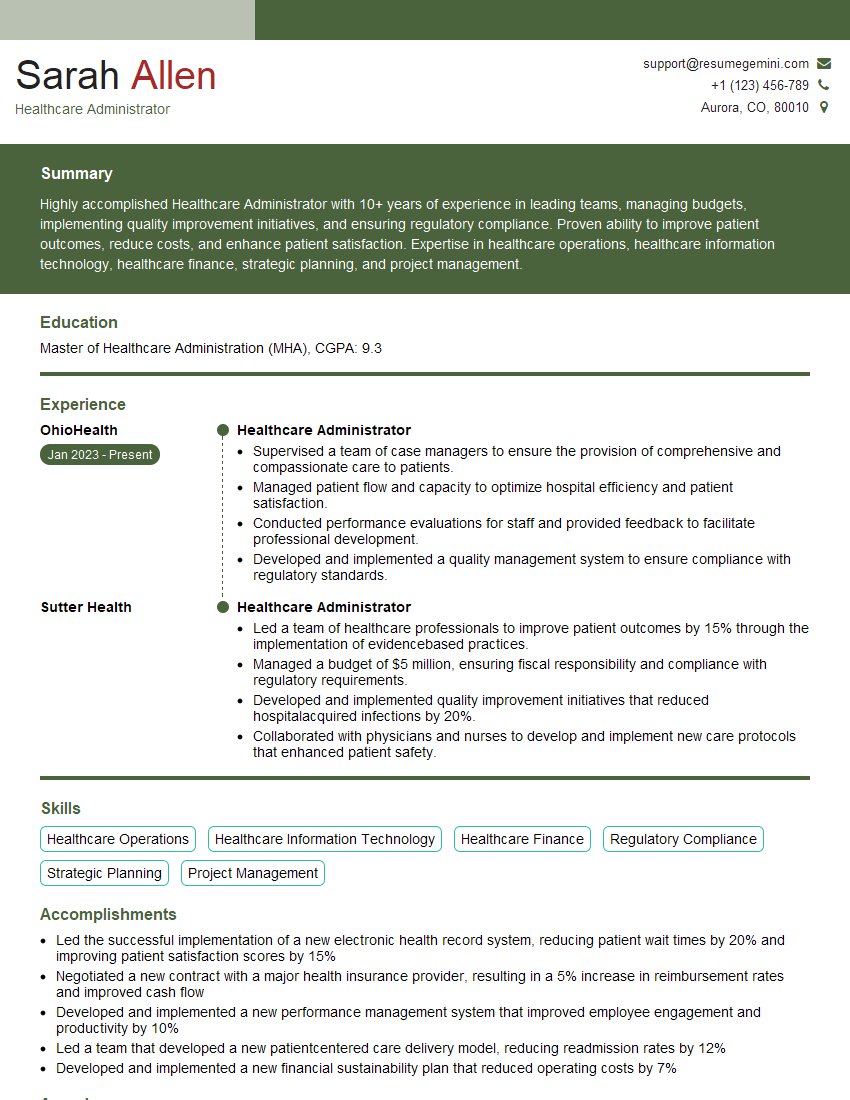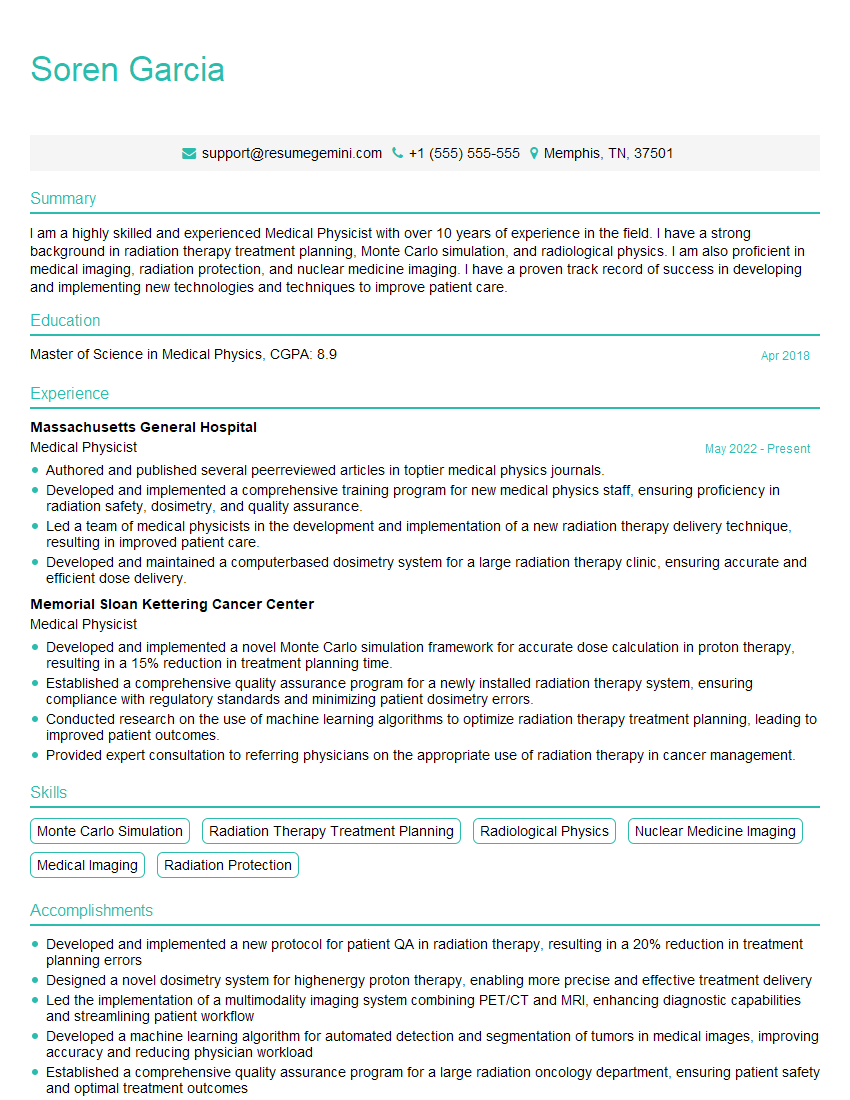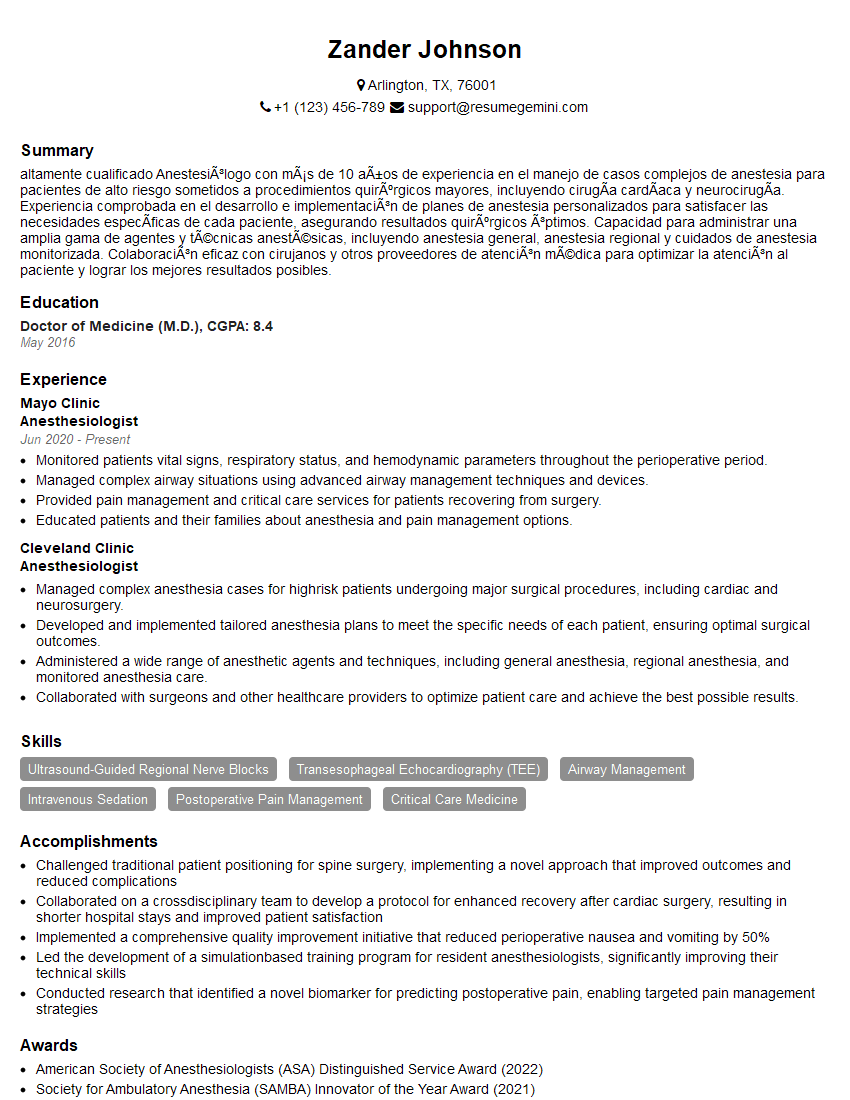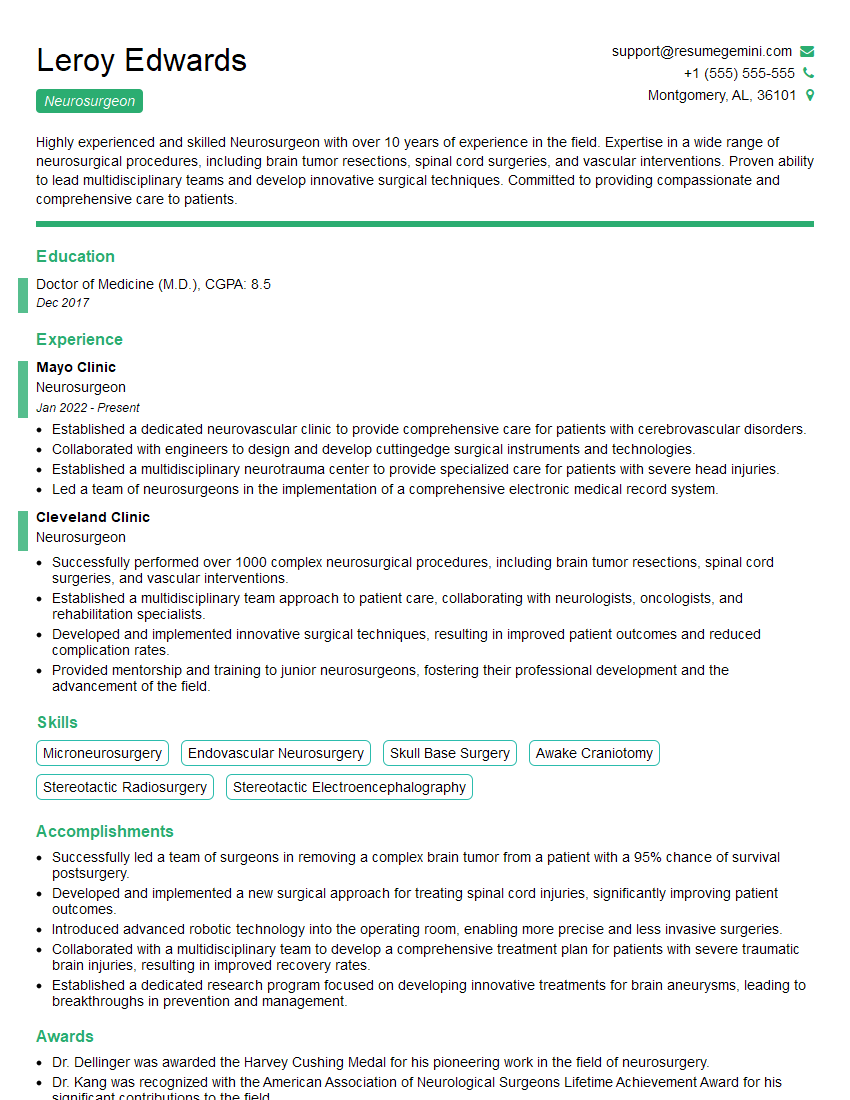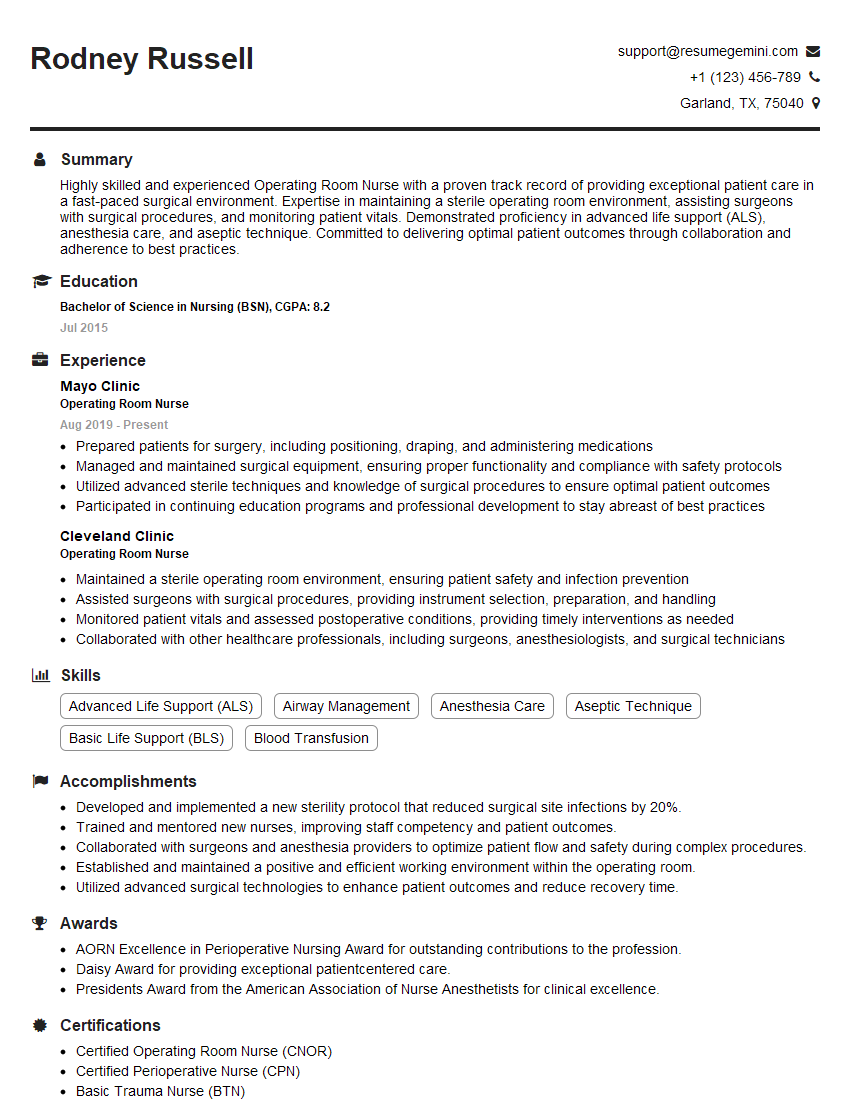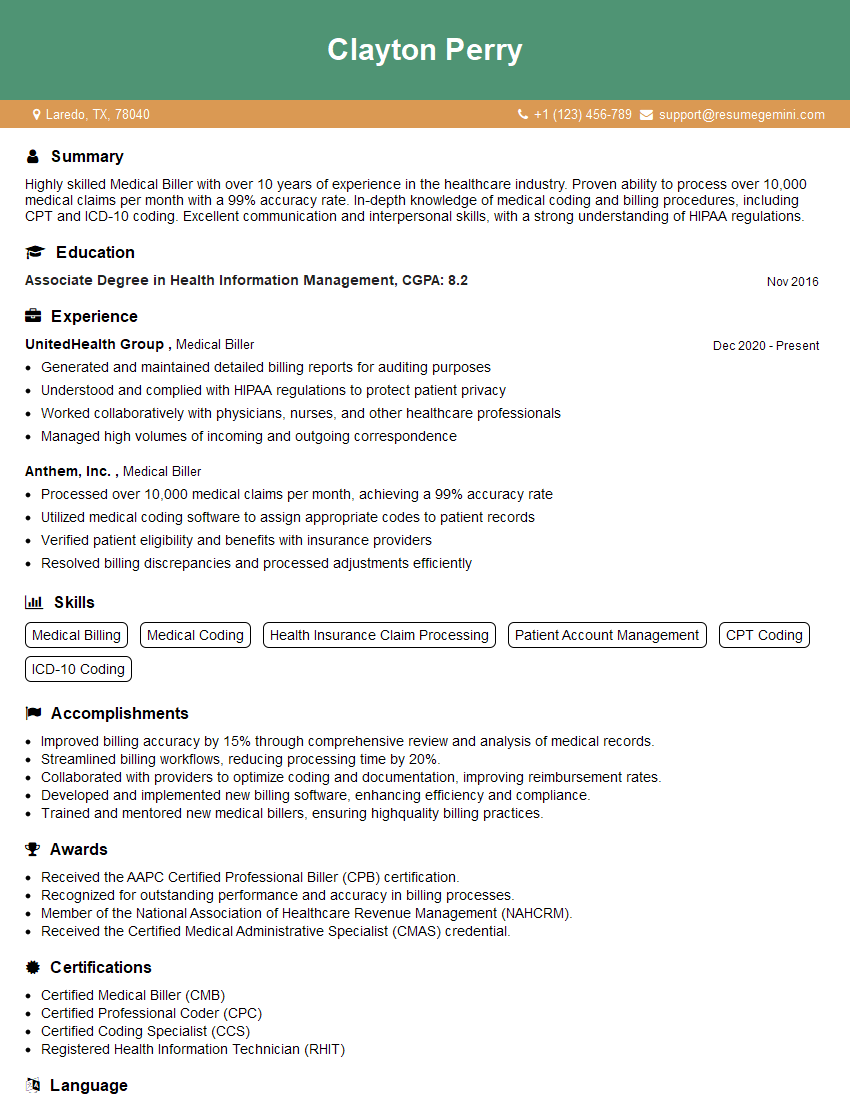Are you ready to stand out in your next interview? Understanding and preparing for Canon Flexion-Distraction Technique interview questions is a game-changer. In this blog, we’ve compiled key questions and expert advice to help you showcase your skills with confidence and precision. Let’s get started on your journey to acing the interview.
Questions Asked in Canon Flexion-Distraction Technique Interview
Q 1. Describe the principles of Canon Flexion-Distraction.
Canon Flexion-Distraction is a non-surgical spinal manipulation technique that uses a specific combination of flexion, distraction, and lateral glide to restore proper spinal mechanics and reduce pain. The core principle lies in gently distracting the vertebrae to create space, reducing pressure on compressed nerves and joints. Simultaneous flexion helps to unlock facet joints, which can become restricted in conditions like degenerative disc disease. The lateral glide component assists in correcting lateral deviations of the spine.
Imagine a stack of slightly misaligned coins. Flexion-distraction acts like gently separating and realigning these coins, relieving the pressure on the lower coins and improving the overall stability of the stack.
Q 2. Explain the indications and contraindications for Canon Flexion-Distraction.
Indications for Canon Flexion-Distraction typically include lumbar disc herniations, facet syndrome, spinal stenosis, spondylolisthesis (in certain cases), and sacroiliac joint dysfunction causing low back pain. It’s often used for patients who haven’t responded well to conservative treatments like physical therapy or medication.
Contraindications include active infections, severe osteoporosis, unstable spinal fractures, advanced spondylolisthesis, severe neurological deficits, pregnancy, and any condition that might make the spinal manipulation risky. A thorough physical exam and imaging studies (X-rays, MRI) are crucial to determine suitability.
For example, a patient with a recent spinal fracture would be unsuitable because the manipulation could worsen the injury. Similarly, a pregnant woman might experience increased risk due to hormonal changes impacting ligament stability.
Q 3. What are the advantages of Canon Flexion-Distraction compared to other spinal techniques?
Canon Flexion-Distraction offers several advantages. Compared to surgery, it’s non-invasive, avoiding the risks and recovery time associated with an operation. Unlike some other spinal manipulation techniques, it’s more controlled and precise, minimizing the risk of injury. It aims to address the underlying mechanical dysfunction, rather than just masking symptoms with pain relief, leading to longer-lasting relief in many patients. Furthermore, it is generally well-tolerated by patients, with relatively quick return to normal activities.
For instance, a patient with a herniated disc might find relief from surgery, but the recovery can take months. Flexion-distraction could provide similar pain relief with much shorter recovery, often involving minimal downtime.
Q 4. What are the potential complications associated with Canon Flexion-Distraction?
While generally safe, potential complications of Canon Flexion-Distraction include temporary worsening of pain, muscle soreness, and rarely, nerve irritation. More serious complications, such as spinal cord injury or fracture, are extremely rare and typically associated with improper technique or patient selection. Post-procedural headaches can sometimes occur. The risk of these complications is significantly reduced with experienced practitioners and careful patient selection.
Careful adherence to protocol, including obtaining informed consent and understanding the patient’s medical history, is paramount in minimizing the risk of complications.
Q 5. How is patient selection crucial for successful Canon Flexion-Distraction?
Patient selection is crucial for the success of Canon Flexion-Distraction. Thorough evaluation is necessary to identify appropriate candidates and rule out contraindications. This includes a detailed history, physical examination, neurological examination, and imaging studies (X-rays, MRI). The practitioner must assess the patient’s pain pattern, range of motion, and neurological status. Patients with specific conditions, like severe osteoporosis or spinal instability, are not suitable candidates.
For example, a patient with radiculopathy (nerve root compression) due to a disc herniation might be an ideal candidate if they meet specific criteria. Conversely, a patient with a significant spinal fracture should be referred for other treatment options.
Q 6. Describe the steps involved in performing a Canon Flexion-Distraction procedure.
The Canon Flexion-Distraction procedure involves a series of carefully controlled movements. The practitioner begins with a thorough assessment of the patient’s spine. Then, the patient is positioned comfortably on the treatment table. The practitioner uses their hands to apply specific forces to achieve flexion, distraction, and lateral glide. These movements are synchronized and controlled to maximize therapeutic effect while minimizing risk of injury. The process may involve multiple repetitions and adjustments based on the patient’s response.
The procedure is not a one-size-fits-all approach. The practitioner must adjust the technique based on the individual patient’s needs and response during the treatment session. The whole process is usually quite gentle and tailored to the patient’s comfort level.
Q 7. What instrumentation is used in Canon Flexion-Distraction surgery?
Canon Flexion-Distraction is a manual technique; therefore, no surgical instrumentation is used. The practitioner’s hands are the primary tools, utilizing their skills and knowledge to apply precise forces to the spine. The treatment table itself might be specially designed to facilitate the necessary movements and provide patient comfort, but no specialized instruments are involved.
The key to this technique’s effectiveness is the practitioner’s skill and experience in delivering the precise forces required for optimal treatment outcomes. This is a technique that truly relies on the practitioner’s expertise.
Q 8. Explain the role of fluoroscopy during a Canon Flexion-Distraction procedure.
Fluoroscopy plays a crucial role in Canon Flexion-Distraction surgery, acting as our ‘eyes’ during the procedure. It provides real-time X-ray imaging, allowing the surgeon to visualize the spinal structures, including the vertebrae, discs, and surrounding soft tissues. This dynamic imaging is essential for several reasons:
- Precise Distraction and Reduction: Fluoroscopy guides the precise separation (distraction) of vertebrae and the correction of spinal deformities. The surgeon can see exactly how much movement is achieved and adjust the distraction devices accordingly.
- Screw Placement Verification: During the insertion of pedicle screws – vital for stabilization – fluoroscopy ensures accurate placement, preventing damage to nerves or blood vessels. We can confirm screw position in multiple planes (anterior-posterior, lateral, oblique).
- Assessment of Spinal Alignment: Throughout the procedure, fluoroscopy helps monitor the correction of the spinal curvature. We can assess the improvement in sagittal, coronal, and axial planes to ensure we’re achieving the desired outcome.
- Intraoperative Adjustments: Should any unforeseen issues arise, such as unexpected bone morphology or soft tissue impingement, fluoroscopy allows for immediate adjustments in the surgical technique.
Imagine trying to build a complex structure with your hands alone – incredibly difficult! Fluoroscopy provides that invaluable ‘visual blueprint’ in real-time, enhancing the precision and safety of the procedure.
Q 9. How is intraoperative monitoring used during Canon Flexion-Distraction?
Intraoperative monitoring during Canon Flexion-Distraction is paramount to patient safety and optimal surgical outcomes. It involves continuous monitoring of several vital parameters to detect any potential neurological or physiological complications.
- Somatosensory Evoked Potentials (SSEPs): These monitor the integrity of the spinal cord’s sensory pathways. Any changes in SSEP waveforms can alert us to potential nerve compression or injury during the distraction process.
- Motor Evoked Potentials (MEPs): These assess the motor pathways of the spinal cord. Similar to SSEPs, changes in MEPs signal potential issues.
- Electroencephalography (EEG): EEG monitors brainwave activity, allowing us to detect any changes that might suggest decreased blood flow or other complications.
- Blood Pressure, Heart Rate, and Oxygen Saturation: Continuous monitoring of these vital signs is crucial for overall patient well-being and to quickly identify any adverse reactions.
This comprehensive monitoring allows for early detection of potential problems, facilitating timely intervention and maximizing the chances of a successful and complication-free surgery. Think of it as having multiple ‘safety nets’ throughout the procedure.
Q 10. What are the postoperative care instructions for patients undergoing Canon Flexion-Distraction?
Postoperative care after Canon Flexion-Distraction is crucial for optimal recovery. Patients typically require a hospital stay of several days. The specific instructions depend on the individual case but generally include:
- Pain Management: Pain medication is prescribed to manage postoperative discomfort. This is often a combination of oral and intravenous analgesics.
- Immobilization: A brace or external support may be used to help stabilize the spine during the initial healing phase. The duration of brace use varies depending on the complexity of the surgery and individual patient factors.
- Physical Therapy: A comprehensive physical therapy program is initiated soon after surgery. This program is tailored to each patient and progresses gradually, focusing on improving range of motion, strength, and overall function.
- Wound Care: Meticulous wound care is essential to prevent infection. Patients are taught proper cleaning and dressing techniques.
- Follow-up Appointments: Regular follow-up appointments are scheduled for monitoring progress, adjusting treatment as needed, and addressing any concerns.
Patient education is key to successful recovery. We provide detailed instructions and answer all questions to empower patients to actively participate in their rehabilitation.
Q 11. How do you manage potential complications such as infection or nerve injury after Canon Flexion-Distraction?
Managing potential complications after Canon Flexion-Distraction is a key aspect of our practice. While rare, complications can occur, requiring prompt and effective intervention.
- Infection: Prophylactic antibiotics are administered before, during, and after surgery to minimize infection risk. If infection does develop, aggressive treatment with intravenous antibiotics and possibly surgical debridement is necessary. Close monitoring of vital signs and wound appearance is crucial.
- Nerve Injury: Intraoperative monitoring helps mitigate the risk of nerve injury. However, if nerve injury does occur, it might manifest as weakness, numbness, or tingling. Depending on the severity, management may range from conservative measures (medication, physical therapy) to surgical intervention.
- Hardware Failure: While uncommon with modern implants, hardware failure can necessitate revision surgery to replace or repair the affected components.
- Pseudarthrosis (Nonunion): This refers to the failure of the bone to heal properly at the fusion site. Treatment may involve bone grafting, revision surgery, or other strategies to promote fusion.
Our approach to managing complications is proactive and multidisciplinary, involving surgeons, nurses, physical therapists, and other specialists as needed. Regular follow-up appointments are key to early detection and treatment of any complications.
Q 12. What are the typical recovery times for patients after Canon Flexion-Distraction?
Recovery times after Canon Flexion-Distraction vary significantly depending on the extent of the surgery, the patient’s overall health, and adherence to the postoperative care plan. However, we can offer some general guidelines:
- Hospital Stay: Typically ranges from a few days to a week.
- Brace/Immobilization: Several weeks to several months, depending on the case.
- Return to Light Activities: A few weeks to a few months.
- Return to Full Activities: Several months to a year or more.
It’s essential to emphasize that recovery is a gradual process. Patients should expect a period of adjustment and should follow their therapist’s guidance closely. The timeline is highly individualized, and patience and perseverance are key factors in successful rehabilitation.
Q 13. Discuss the long-term outcomes and success rates associated with Canon Flexion-Distraction.
Long-term outcomes and success rates associated with Canon Flexion-Distraction are generally favorable. Success is often measured by pain reduction, improvement in spinal alignment, and restoration of function. However, individual results can vary.
- Pain Relief: A significant percentage of patients experience substantial pain relief. This is often a primary goal of the procedure.
- Improved Alignment: The procedure effectively corrects spinal deformities, improving posture and reducing associated symptoms.
- Functional Improvement: Patients often experience an improvement in their ability to perform daily activities.
- Fusion Success Rates: High fusion rates are typically reported in the literature, signifying successful bony healing at the fusion sites.
The long-term success of Canon Flexion-Distraction is also highly dependent on several factors, including patient compliance with the postoperative regimen, careful surgical technique, and effective postoperative management of potential complications. A collaborative approach between surgeon, patient, and rehabilitation team is vital for optimal long-term outcomes.
Q 14. How do you assess the effectiveness of Canon Flexion-Distraction in a patient?
Assessing the effectiveness of Canon Flexion-Distraction requires a multi-faceted approach, going beyond just looking at radiographic findings.
- Clinical Examination: Regular clinical evaluations assess pain levels, range of motion, neurological function (strength, sensation), and overall functional ability.
- Radiographic Imaging: Postoperative X-rays and CT scans evaluate the spinal alignment and assess fusion progression. This ensures the spine is healing and stabilizing correctly.
- Patient-Reported Outcome Measures (PROMs): Questionnaires and scales are used to quantify the patient’s perception of pain, function, and overall quality of life. These are essential in capturing the patient’s subjective experience.
- Functional Assessments: Formal assessments quantify a patient’s ability to perform activities of daily living, providing objective measures of functional improvement.
By combining objective measurements (imaging, functional tests) with the patient’s subjective experience (PROMs), we obtain a holistic picture of the procedure’s effectiveness. This comprehensive approach helps tailor ongoing management and optimize patient outcomes. For example, a patient might report significant pain reduction despite minor radiographic evidence of incomplete fusion, emphasizing the importance of a holistic assessment.
Q 15. Compare and contrast Canon Flexion-Distraction with other minimally invasive spinal techniques.
Canon Flexion-Distraction (CFD) is a minimally invasive spinal technique that differs significantly from other approaches like spinal fusion or discectomy. While other minimally invasive procedures often focus on direct surgical intervention at the affected disc or vertebral segment, CFD employs a unique approach of gentle distraction and flexion to restore spinal mechanics and reduce pain.
- CFD uses a specialized table and instrument to apply controlled flexion and distraction forces to the spine, aiming to reduce disc herniation, improve joint mobility, and reduce nerve compression. It is often used for lumbar spinal stenosis and disc herniations.
- Minimally invasive discectomy, for example, involves directly removing portions of the herniated disc through a small incision. This is a more localized approach compared to CFD’s whole-segment manipulation.
- Spinal fusion, a more invasive procedure, involves permanently joining two or more vertebrae, eliminating motion but also potentially impacting spinal flexibility. CFD aims to preserve motion and improve function.
In short, while all these techniques aim to alleviate spinal pain and dysfunction, CFD differentiates itself by its non-surgical, whole-segment approach that focuses on restoring the natural biomechanics of the spine instead of directly removing or fusing components.
Career Expert Tips:
- Ace those interviews! Prepare effectively by reviewing the Top 50 Most Common Interview Questions on ResumeGemini.
- Navigate your job search with confidence! Explore a wide range of Career Tips on ResumeGemini. Learn about common challenges and recommendations to overcome them.
- Craft the perfect resume! Master the Art of Resume Writing with ResumeGemini’s guide. Showcase your unique qualifications and achievements effectively.
- Don’t miss out on holiday savings! Build your dream resume with ResumeGemini’s ATS optimized templates.
Q 16. What are the limitations of Canon Flexion-Distraction?
Despite its advantages, CFD has limitations. It is not suitable for all patients or conditions.
- Severe spinal instability: CFD may not be appropriate for patients with significant spinal instability or severe spondylolisthesis, where the vertebrae have shifted significantly.
- Severe nerve compression: In cases of severe nerve root compression that requires immediate decompression, CFD might not provide sufficient relief. Surgical intervention may be necessary.
- Spinal fractures or infections: CFD is contraindicated in patients with spinal fractures or infections.
- Patient adherence: Success with CFD depends partly on patient adherence to post-treatment recommendations, including physical therapy and exercise regimens. Lack of adherence can hinder recovery.
- Specific anatomical limitations: Certain spinal anatomies may not be conducive to the precise application of flexion and distraction forces required for effective treatment.
Careful patient selection and a thorough pre-operative assessment are crucial to identify if CFD is the appropriate treatment.
Q 17. How do you address patient anxieties and concerns before a Canon Flexion-Distraction procedure?
Addressing patient anxieties is a crucial aspect of providing excellent care. Before a CFD procedure, I thoroughly explain the procedure using simple language, avoiding medical jargon. I show them videos and diagrams to visually illustrate the process.
- Detailed explanation: I describe what will happen step by step, highlighting the sensations they can expect during the procedure (gentle pressure, pulling, stretching).
- Addressing concerns: I proactively address common concerns, such as pain, recovery time, and potential risks. I encourage them to ask questions, and provide honest and transparent answers.
- Realistic expectations: I set realistic expectations regarding the outcome. While CFD has a high success rate, it’s essential to acknowledge that results can vary.
- Meet the team: Introducing the medical team involved helps alleviate apprehension. A familiar face can make a difference.
- Post-procedure care discussion: Explaining the post-procedure care plan and rehabilitation program will help ease their concerns about their recovery journey.
Building trust and rapport is key to reducing anxieties. A calm and empathetic approach can significantly improve the patient experience.
Q 18. What are the ethical considerations associated with Canon Flexion-Distraction?
Ethical considerations are paramount in any medical procedure. With CFD, some key ethical considerations include:
- Informed Consent: Patients must provide fully informed consent, understanding the procedure, its benefits, risks, and alternatives. This requires clear communication in accessible language.
- Patient Selection: Careful patient selection is crucial to ensure the procedure is appropriate and will likely benefit them. Avoiding unnecessary procedures is an ethical obligation.
- Transparency: Maintaining transparency about potential complications, success rates, and financial implications is essential.
- Competence: Only appropriately trained and experienced healthcare professionals should perform CFD.
- Research and Continuing Education: Staying abreast of the latest research and continuing education is crucial to ensure ethical and effective practice.
Adherence to established medical guidelines and ethical principles is vital to ensure patient safety and well-being.
Q 19. Explain the role of imaging (X-ray, CT, MRI) in Canon Flexion-Distraction.
Imaging plays a critical role in both pre- and post-operative assessment in CFD. It helps guide the procedure and monitor its effectiveness.
- Pre-operative imaging (X-ray, CT, MRI): These are used to identify the specific spinal pathology, assess the severity of disc herniation or stenosis, and rule out other conditions. This helps determine patient suitability for CFD.
- Post-operative imaging: Follow-up imaging is used to evaluate the effectiveness of the treatment, assess spinal alignment, and identify any complications. This helps monitor healing and recovery progress.
For example, pre-operative MRI can show the exact location and size of a disc herniation, helping the clinician plan the precise application of flexion and distraction forces. Post-operative X-rays may show improved disc space height or alignment after the procedure.
Q 20. Describe the biomechanics of the spine relevant to Canon Flexion-Distraction.
Understanding the biomechanics of the spine is crucial for effective CFD. The technique is based on the principle that controlled flexion and distraction can restore the normal biomechanics of the spine.
- Intervertebral disc mechanics: The intervertebral discs act as shock absorbers and allow for spinal movement. CFD aims to reduce pressure on the discs by creating space and relieving compression on nerves.
- Facet joint mechanics: The facet joints guide spinal movement. CFD aims to improve the joint’s mobility and reduce inflammation.
- Spinal alignment: Maintaining proper spinal alignment is essential for optimal function. CFD aids in correcting any malalignment that may be contributing to pain.
In essence, CFD aims to address spinal pain by restoring the normal movement and alignment of the spine, rather than directly addressing the pathology in an invasive way. The procedure subtly manipulates these biomechanical components to alleviate pain.
Q 21. What are the different types of distractors used in Canon Flexion-Distraction?
The type of distractor used depends on the specific needs of the patient and the location of the spinal pathology. While there isn’t a standardized taxonomy of distractors in the literature, the design principles remain consistent.
Generally, distractors are designed to facilitate controlled flexion and distraction of the spine. They might feature different configurations for lumbar versus cervical spine applications. They are typically part of a larger table system that allows for precise adjustment of the forces applied.
The specific designs and features of these distractors vary among manufacturers and are constantly evolving with advancements in technology and clinical experience.
It’s vital to note that the success of CFD isn’t solely dependent on the type of distractor used. The skill and experience of the clinician in properly applying the flexion-distraction forces and tailoring the treatment to the individual patient are just as important, if not more so.
Q 22. How do you handle unexpected intraoperative challenges during a Canon Flexion-Distraction procedure?
Handling unexpected intraoperative challenges during a Canon Flexion-Distraction procedure requires a combination of pre-operative planning, intraoperative adaptability, and a deep understanding of the technique. Unexpected challenges can range from anatomical variations to instrument malfunction.
For example, encountering significant spinal stenosis beyond what was pre-operatively visualized on imaging requires careful adjustments to the distraction strategy. We might need to modify the distraction vector or the amount of distraction to avoid neurological compromise. This requires meticulous intraoperative monitoring, including somatosensory evoked potentials (SSEPs) and motor evoked potentials (MEPs) to ensure neurological integrity. If instrument malfunction occurs, having backup instruments and a clear plan for contingency are crucial. For example, if a distraction rod fails, we have a protocol in place for immediately replacing it with a suitable alternative. This necessitates thorough familiarity with all aspects of the instrumentation and the ability to adapt the surgical plan on the fly.
Ultimately, effective management hinges on experience, meticulous planning, a robust monitoring system, and a team capable of reacting swiftly and appropriately to unforeseen circumstances. A calm, methodical approach is essential in these situations.
Q 23. Discuss your experience with specific instrumentation used in Canon Flexion-Distraction.
My experience with instrumentation in Canon Flexion-Distraction is extensive. We primarily utilize the specific instruments designed for this technique, including specialized distraction rods, clamps, and screws. These are designed to allow controlled and gradual distraction of the spine, with precise adjustments possible throughout the procedure. The instrumentation is critical because it allows for minimally invasive surgery, reducing the trauma to surrounding tissues.
For example, the use of smaller diameter screws allows for less bone removal, contributing to reduced trauma and faster recovery. The precision of the distraction rods is also important, allowing us to achieve the desired correction while minimizing the risk of complications. I’ve found that a thorough understanding of the instrumentation, including its capabilities and limitations, is vital for a successful outcome. Regular maintenance and familiarity with troubleshooting procedures are also key to ensuring smooth procedures. I regularly participate in training and workshops to stay current with the latest advancements in instrumentation.
Q 24. Describe your experience with patient education and counseling related to Canon Flexion-Distraction.
Patient education and counseling are integral to the success of a Canon Flexion-Distraction procedure. This begins with a thorough explanation of the condition, the surgical procedure, and the expected recovery process. I explain the procedure using clear, simple language, avoiding complex medical jargon. I use anatomical models and diagrams to help patients visualize the process and understand what will happen during the surgery.
I address common patient concerns, such as pain management, potential risks, and limitations. I emphasize the importance of compliance with the post-operative rehabilitation protocol, which is crucial for achieving optimal outcomes. I also provide realistic expectations about the recovery period and the long-term results. For example, I discuss the potential for residual pain or stiffness, and I explain how to manage these issues. I encourage patients to ask questions and provide them with resources, such as informational pamphlets and websites, to reinforce their understanding. I’ve found that a supportive and empathetic approach is essential in fostering a strong patient-physician relationship and maximizing patient compliance.
Q 25. How do you assess patient satisfaction after Canon Flexion-Distraction surgery?
Assessing patient satisfaction after Canon Flexion-Distraction surgery involves a multi-faceted approach. We utilize both quantitative and qualitative methods. Quantitative methods include standardized questionnaires that assess pain levels, functional outcomes, and overall satisfaction using validated scales such as the Oswestry Disability Index (ODI) and visual analogue scales (VAS) for pain.
Qualitative methods include in-person interviews and follow-up appointments where we delve deeper into the patient’s experience. We explore aspects such as their perception of the surgical process, their satisfaction with the communication and care they received, and their overall quality of life after surgery. I find that combining quantitative data with qualitative feedback provides a much more comprehensive understanding of patient satisfaction. For example, a patient might report low pain scores on a questionnaire but express concerns about limitations in their daily activities during an interview. Addressing this disparity allows us to identify areas for improvement in our care and to tailor our approach to individual patient needs. Regular follow-up appointments are key to identifying and addressing any long-term concerns.
Q 26. Explain the importance of meticulous surgical technique in Canon Flexion-Distraction.
Meticulous surgical technique is paramount in Canon Flexion-Distraction because even minor errors can have significant consequences. This technique involves precise placement of implants and controlled distraction, which affects spinal alignment and stability.
For instance, improper placement of the distraction rods can lead to instability, nerve impingement, or implant failure. Inadequate distraction can result in insufficient correction of the deformity, while excessive distraction can cause injury to the surrounding tissues. To achieve a successful outcome, we must utilize precise instrumentation, adhere to strict surgical protocols, and employ intraoperative imaging such as fluoroscopy to verify implant placement and distraction. The surgeon’s experience and judgment are also crucial in adapting to intraoperative findings and ensuring that the distraction proceeds smoothly and safely. Regular training and staying updated on the latest surgical techniques and advancements are essential for maintaining proficiency.
Q 27. Describe your understanding of the research and evidence supporting the use of Canon Flexion-Distraction.
The research and evidence supporting Canon Flexion-Distraction are substantial, demonstrating its effectiveness in treating various spinal deformities. Numerous studies have documented its efficacy in correcting sagittal imbalance, improving spinal alignment, and reducing pain in patients with conditions such as adult spinal deformity and degenerative spondylolisthesis.
These studies generally demonstrate positive outcomes in terms of improved patient reported outcomes, including reduced pain, improved function, and increased patient satisfaction. The long-term durability of the correction has also been a focus of research. However, it’s important to note that like any surgical procedure, there are potential risks and complications associated with Canon Flexion-Distraction. Therefore, it’s crucial to carefully consider patient-specific factors such as overall health, age, and the severity of the deformity when determining the suitability of this procedure. Ongoing research continues to refine the technique and further expand our understanding of its long-term efficacy and safety.
Q 28. How would you explain the procedure to a patient and their family?
Explaining the Canon Flexion-Distraction procedure to a patient and their family involves a clear, concise, and compassionate approach. I begin by establishing a comfortable and supportive environment, encouraging open communication and addressing any concerns they might have.
I start by explaining the patient’s condition in simple terms, using analogies or illustrations when necessary. I then describe the surgical procedure, explaining that it involves the gradual correction of the spinal deformity using specialized instruments that allow for controlled stretching of the spine. I would use anatomical models or diagrams to illustrate the process visually. I emphasize the minimally invasive nature of the procedure and highlight its benefits, such as improved posture, reduced pain, and increased functionality. Importantly, I discuss potential risks and complications in an honest and transparent manner, without creating unnecessary fear. I provide realistic expectations regarding the recovery process, emphasizing the importance of physical therapy and post-operative compliance. The goal is to empower the patient and their family with a comprehensive understanding of the procedure, allowing them to make informed decisions.
Key Topics to Learn for Canon Flexion-Distraction Technique Interview
- Biomechanics of the Spine: Understanding the anatomical structures involved and how the Canon Flexion-Distraction technique interacts with them. This includes a thorough grasp of spinal segments, ligaments, and intervertebral discs.
- Principles of Flexion-Distraction: Mastering the theoretical underpinnings of the technique, including the specific mechanisms of distraction, flexion, and the resulting effects on spinal structures.
- Patient Selection and Assessment: Developing the ability to identify suitable candidates for this treatment method, including understanding contraindications and potential risks. This includes proficiency in conducting thorough patient examinations and interpreting diagnostic imaging.
- Treatment Protocol and Technique: Gaining hands-on experience and a deep understanding of the proper application of the Canon Flexion-Distraction technique, paying attention to detail and precision in each step.
- Post-Treatment Care and Patient Education: Understanding the importance of post-treatment instructions and educating patients about recovery expectations and potential complications. Knowing how to manage and address common post-treatment issues.
- Troubleshooting and Problem Solving: Developing the capacity to identify and address potential challenges during treatment, such as patient discomfort or unexpected responses. This includes the ability to adapt the technique based on individual patient needs.
- Research and Evidence-Based Practice: Familiarizing yourself with the latest research and evidence supporting the efficacy of the Canon Flexion-Distraction technique. Being able to discuss clinical studies and outcomes.
- Ethical Considerations and Professional Standards: Understanding the ethical implications and professional guidelines surrounding the application of this technique. Maintaining patient confidentiality and adhering to best practices.
Next Steps
Mastering the Canon Flexion-Distraction Technique can significantly enhance your career prospects in chiropractic care and related fields. Demonstrating a strong understanding of this technique will set you apart from other candidates. To maximize your chances of success, creating an ATS-friendly resume is crucial. ResumeGemini is a trusted resource to help you build a professional and effective resume that highlights your skills and experience. Examples of resumes tailored to the Canon Flexion-Distraction Technique are available to further assist you in showcasing your qualifications.
Explore more articles
Users Rating of Our Blogs
Share Your Experience
We value your feedback! Please rate our content and share your thoughts (optional).
What Readers Say About Our Blog
This was kind of a unique content I found around the specialized skills. Very helpful questions and good detailed answers.
Very Helpful blog, thank you Interviewgemini team.
